Rail Travel around Tokyo
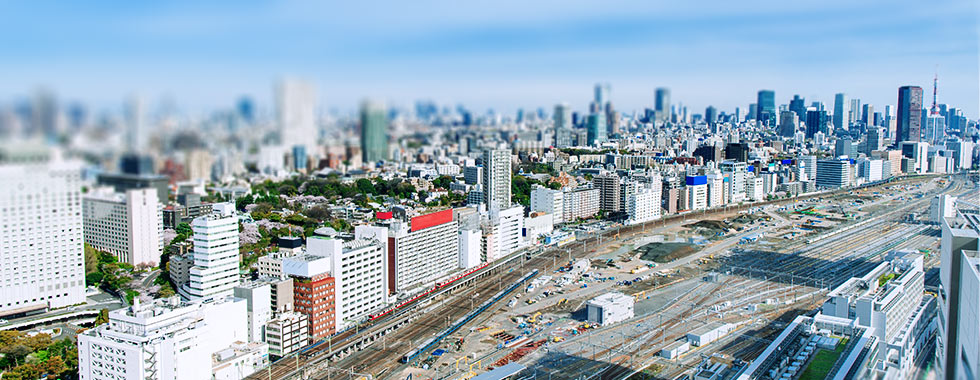
The Tokyo public transport system is the fastest and the most convenient way to travel around the city. It is advisable to avoid the morning rush hour between 7:30am and 9am, as during these hours trains are often so busy that passengers must be pushed to fit onto the train by station staff. In general, both overground trains and subways run from around 5am to 1am.
Overground Trains
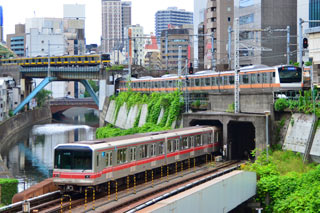
The overground rail network in Tokyo is mostly operated by JR East. There are also around seven other private companies operating lines within the city, and linking the city to other prefectures. At stations with lines of more than one company, each company’s lines will typically have its own ticket gates. Transferring between two companies’ rail lines (including the subways) usually means paying a separate fare for each stage of the journey. Where possible, it is cheapest to stick to a single company’s lines for each journey.
You will find that some trains transfer from one line to another, and in some cases between companies, along a single route. An example is the Tobu Tojo Line, which may transfer to Tokyo Metro’s Fukutoshin Line, then to the Tōkyū Tōyoko Line before finally becoming the Minatomirai Line.
Station names are written in kanji, hiragana, and English. Train announcements are made in Japanese and English on major lines.
JR
JR has more lines in Tokyo than any other company. The center of the system is the Yamanote Line, which loops around the city and links to all the major stations. The Chuo Line cuts across the Yamanote “loop” between Shinjuku and Tokyo stations. Other major lines include the Saikyo line, which links Tokyo with Saitama Prefecture, the Keihin-Tōhoku line, linking Saitama and Yokohama through central Tokyo, and the Keiyō Line, which links Tokyo with Chiba Prefecture and the Tokyo Disney Resorts.
- JR East (East Japan Railway Company)
- https://www.jreast.co.jp/e/
- JR East Infoline
- https://www.jreast.co.jp/e/customer_support/infoline.html
- Tel: 050-2016-1603 / 10:00am-6:00pm
Private rail
Keio
— has six lines in the Tokyo Metropolitan area. Two of the main lines are the Keio Line/Keio New Line linking Shinjuku and Hachioji, and the Keio Inokashira Line, linking Shibuya and Kichijoji. The Keio New Line is connected to the Toei Shinjuku Line.
https://www.keio.co.jp/english/
Odakyū
— has three lines in Tokyo and Kanagawa, notably the Odawara line linking Shinjuku and Odawara. The Enoshima Line reached to Enoshima. It is connected to the Tokyo Metro Chiyoda Line.
https://www.odakyu.jp/english/transport/
Seibu
— has a number of lines and branches, including the Seibu Shinjuku line, linking Shinjuku and Saitama, and the Seibu Ikebukuro Line, linking Ikebukuro and Saitama. The Seibu Ikebukuro Line is connected to the Tokyo Metro Yurakucho Line and the Fukutoshin Line, and is also directly connected to the Tokyu Toyoko Line and the Minatomirai Line via the Fukutoshin Line.
https://www.seiburailway.jp/railways/tourist/english/
Tōkyū
— has seven lines in Tokyo, including the Tōyoko line, linking Shibuya and Yokohama, the Den-en-toshi Line, linking Shibuya and Yamato in Kanagawa, and connect to Tokyo Metro Hanzomon Line. The Meguro line, linking Meguro and Yokohama and connect to Tokyo metro Namboku Line. The Oimachi line connects Mioiguchi from Oimachi, the Ikegami line connects Gotanda to Kamata, and the Setagaya line connects Shimotakaido from Sangenjaya.
https://www.tokyu.co.jp/global/english/
Keikyū
— has five lines in the Tokyo and Yokohama areas, including the Keikyū Main Line, linking Tokyo’s Minato Ward with Yokosuka in Kanagawa, and the Airport Line, linking Kamata with Haneda International Airport. Directly connected to the Keisei Line via the Toei Askusa Line.
https://www.haneda-tokyo-access.com/en/
Keisei
— has seven lines in Tokyo and Chiba, including the Main and Narita Airport Lines linking Tokyo to Narita International airport. Directly connected to the Keikyu Line via the Toei Askusa Line.
http://www.keisei.co.jp/keisei/tetudou/skyliner/us/index.php
Tobu
— has thirteen lines in and around Tokyo, including the Skytree Line which links Asakusa with Miyashiro in Saitama, and the Kameido Line, linking Hikifune and Kameido in central Tokyo.
http://www.tobu.co.jp/foreign/en/
Sotetsu
— has two lines in Kanagawa, from Yokohama to Ebina or Shonandai.
Service Types
There are several names used for different train services, which indicate the speed of the train (see below). Faster trains will skip some stations, so make sure the train you ride will stop at your destination. To speed up your trip, take a rapid or express train until the last stop before your destination, and then transfer to a local train.
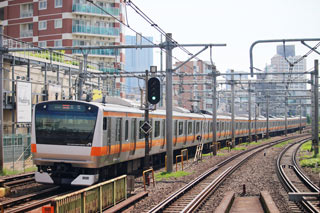
- Train Services (slowest to fastest)
- LOCAL: 普通 (futsuu) 各停 (kakutei)
- Local trains stop at every station along the route.
- RAPID: 快速 (kaisoku)
- Rapid trains skip some stations to cut down on travel times.
- COMMUTER RAPID: 通勤快速 (tsuukin kaisoku)
- Commuter rapids run only during morning and evening rush hours, with speeds similar to express trains.
- EXPRESS: 急行 (kyuukou)
- Express trains stop at fewer stations than rapid trains. JR charges an express fee in addition to the base fare.
- LIMITED EXPRESS: 特急 (tokkyuu)
- The fastest of type of regular train, a limited express train stops only at major stations. JR charges a limited express fee in addition to the base fare, but some private railway companies do not.
Subways
Tokyo’s subway system covers many areas that the overground rail network does not. Subway services are operated by two companies – Tokyo Metro, which has 9 lines, and Toei Subway, which has four. For ease of use, each station is coded with a letter and number. You will find these on platform signs and route maps. Both companies use coloured circles with a letter representing the name of the line on signs at the various stations, but as they are different companies they each have their own ticket gates.
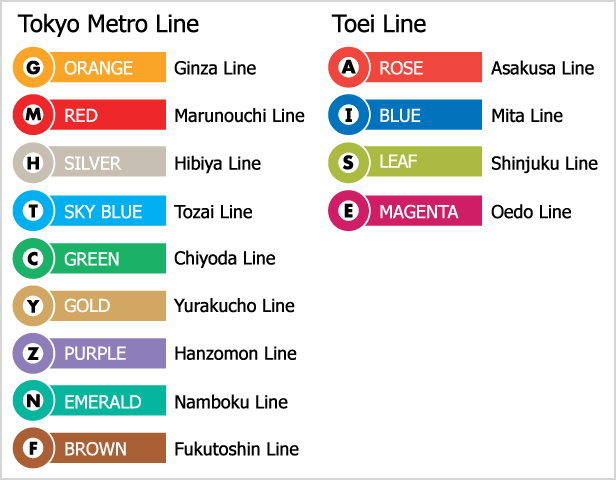
Around Yokohama Area, Yokohama Municipal Subway runs by Transportation Bureau, City of Yokohama. It has two lines in Yokohama city to Fujisawa city
- Tokyo Metro
- https://www.tokyometro.jp/en/
- Toei Subway
- https://www.kotsu.metro.tokyo.jp/eng/
- Yokohama Municipal Subway
- https://www.city.yokohama.lg.jp/kotsu/sub/ (Japanese)
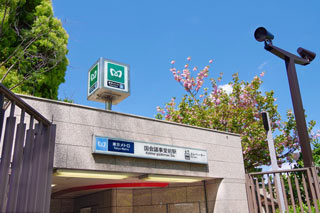
Here is a railway map that covers JR, private railways, and subways.
- Tokyo Railway Map
- https://expatsguide.jp/wp/wp-content/uploads/railwaymap-tokyo_2019-v2-2.pdf
- Yokohama Railway Map
- https://expatsguide.jp/wp/wp-content/uploads/railwaymap-yokohama_2019-v2.pdf